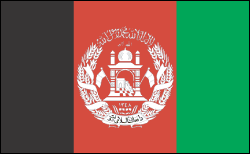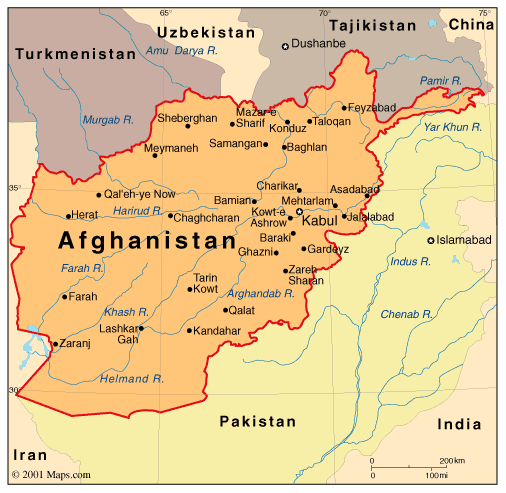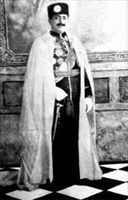 |
|
Facts National name:De Afghanistan Eslami Jamhoryiat/ Jomhuri-ye Eslami Afghanestan President:
Hamid Karzai (2002) Total area: 250,000 sq mi (652 000 sq km) Population (2007 est.): 31,889,923 (growth rate: 2.6%); birth rate: 46.2/1000; infant mortality rate: 157.4/1000; life expectancy: 43.8; density per sq mi: 128 Capital and largest city (2003 est.):Kabul, Other large cities: Kandahar, 349,300; Mazar-i-Sharif, 246,900; Charikar, 202,600; Herat, 171,500 Monetary unit: Afghani Languages: Pashtu ,Dari other Turkic and minor languages Religion: Islam (Sunni 80%, Shiite 19%), other 1% Literacy rate: 36% (1999 est.) GeographyAfghanistan is located in the heart of Asia and is bordered on the north by Turkmenistan, Uzbekistan, and Tajikistan, on the extreme northeast by China, on the east and south by Pakistan, and by Iran on the west. The country is split east to west by the Hindu Kush mountain range, rising in the east to heights of 24,000 ft (7,315 m). With the exception of the southwest, most of the country is covered by high snow-capped mountains and is traversed by deep valleys. HistoryDarius I and Alexander the Great were the first to use Afghanistan as the gateway to India. Islamic conquerors arrived in the 7th century, and Genghis Khan and Tamerlane followed in the 13th and 14th centuries. In the 19th century, Afghanistan became a battleground in the rivalry
between imperial Britain and During the cold war, King Mohammed Zahir Shah developed close ties with the Soviet Union, accepting extensive economic assistance from Moscow. He was deposed in 1973 by his cousin Mohammed Daoud, who proclaimed a republic. Daoud was killed in a 1978 coup, and Noor Taraki took power, setting up a Marxist regime. He, in turn, was executed in Sept. 1979, and Hafizullah Amin became president. Amin was killed in Dec. 1979, as the Soviets launched a full-scale invasion of Afghanistan and installed Babrak Karmal as president. The Soviets, and the Soviet-backed Afghan government, were met with fierce popular resistance. Guerrilla forces, calling themselves mujahideen, pledged a jihad, or holy war, to expel the invaders. Initially armed with outdated weapons, the mujahideen became a focus of U.S. cold war strategy against the Soviet Union, and with Pakistan's help, Washington began funneling sophisticated arms to the resistance. Moscow's troops were soon bogged down in a no-win conflict with determined Afghan fighters. In 1986 Karmal resigned, and was replaced by Mohammad Najibullah. In April 1988 the USSR, U.S., Afghanistan, and Pakistan signed accords calling for an end to outside aid to the warring factions. In return, a Soviet withdrawal took place in Feb. 1989, but the pro-Soviet government of President Najibullah was left in the capital, Kabul. By mid-April 1992 Najibullah was ousted as Islamic rebels advanced on the capital. Almost immediately, the various rebel groups began fighting one another for control. Amid the chaos of competing factions, a group calling itself the Taliban�consisting of Islamic students�seized control of Kabul in Sept. 1996. By fall 1998 the Taliban controlled about 90% of the country and.Only three countries�Pakistan, Saudi Arabia, and the UAR�recognized the Taliban as Afghanistan's legitimate government. More coming soon... |
|
|


